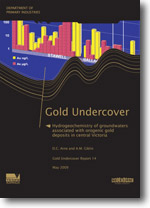GU Report 14 - Hydrogeochemistry of groundwaters associated with orogenic gold deposits in central Victoria
 |
| |||||||||||||||
Product description:Executive summary Data for 1133 groundwater samples from southeastern Australia have been obtained over a period of 20 years by CSIRO Exploration and Mining. These samples include 928 samples from central Victoria, mainly from the Stawell–Ararat region, Creswick, Bendigo (southern Murray Basin) and the northern Murray Basin west of Swan Hill. This report presents the entire data set of 1133 samples (in Appendix 1), provides a brief description of how the samples were collected and analysed, and an interpretation of the Au and As data. Gold in groundwater was adsorbed onto sachets of activated carbon that were then analysed by instrumental neutron activation. Arsenic content was determined by hydride generation atomic absorption spectroscopy. Although the groundwater samples show a wide range of conductivities (i.e. salinity), this appears to have very little effect on Au and As concentrations in the samples. The spatial distributions of both elements show a good correspondence with known historical gold deposits at Stawell, Bendigo, Ballarat and Ararat, as well as the recently discovered Tandarra deposit north of Bendigo. Threshold values for Au vary according to the region sampled, but range between 5 and 50 ng/L. Threshold values for As range between 3 and 20 μg/L. Gold and As are the most reliable indicators of bedrock Au mineralisation. Concentrations of trace elements Cu, Ag, Mo and S (as sulphate) vary with groundwater conductivity and pH. They are less reliable indicators of bedrock Au mineralisation, although they may be at elevated concentrations in bedrock adjacent to mineralisation. Hydrogeochemical studies provide a suitable reconnaissance method for Au exploration in undercover areas, but their effectiveness depends on the degree of groundwater interaction with mineralised bedrock and the availability of suitable bores for sampling. An understanding of groundwater geochemistry and flow pathways can be obtained by using careful sampling control and maximising available hydrogeological information. Hydrogeochemical data should be interpreted in combination with palaeotopographic and geophysical information, and followed by other exploration methods such as soil geochemistry, biogeochemistry and, once exploration drilling commences, lithogeochemistry. Download The downloadable version of this report is supplied in PDF format. An appendix in MS Excel format is also supplied. Bibliographic reference Arne, D.C. & Giblin, A.M., 2009. Hydrogeochemistry of groundwaters associated with orogenic gold deposits in central Victoria. GeoScience Victoria Gold Undercover Report 14. Department of Primary Industries. Related products:
| ||||||||||||||||


